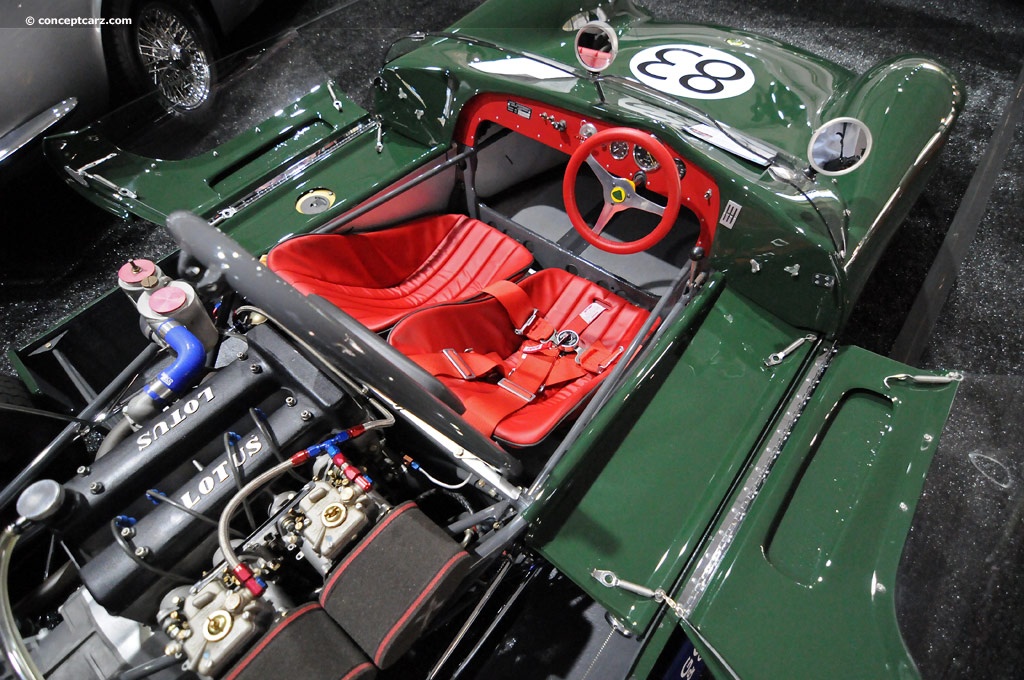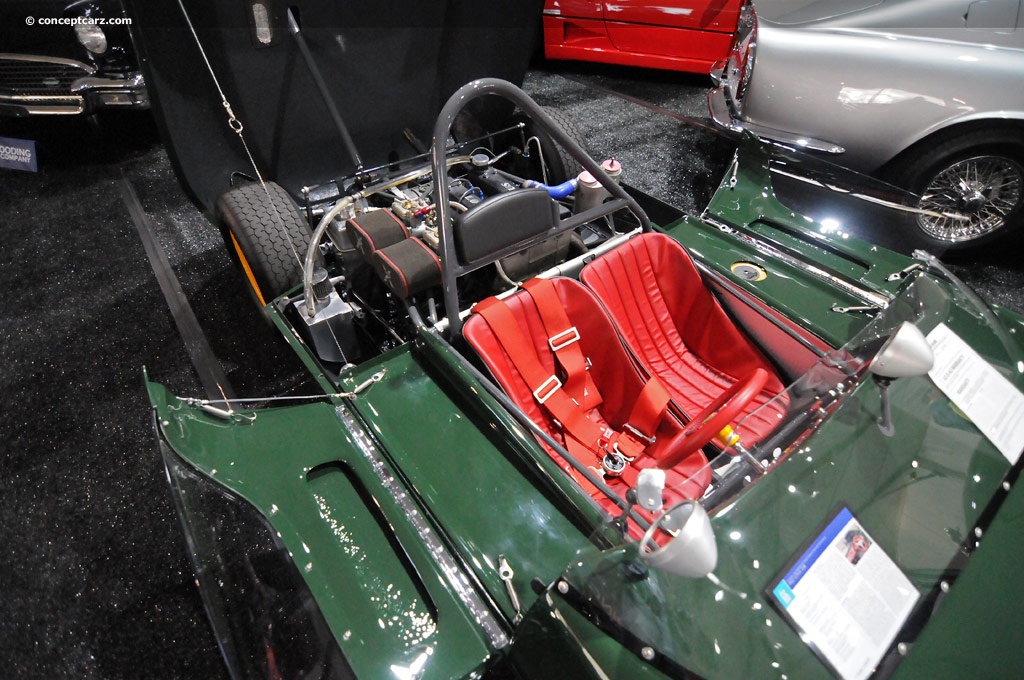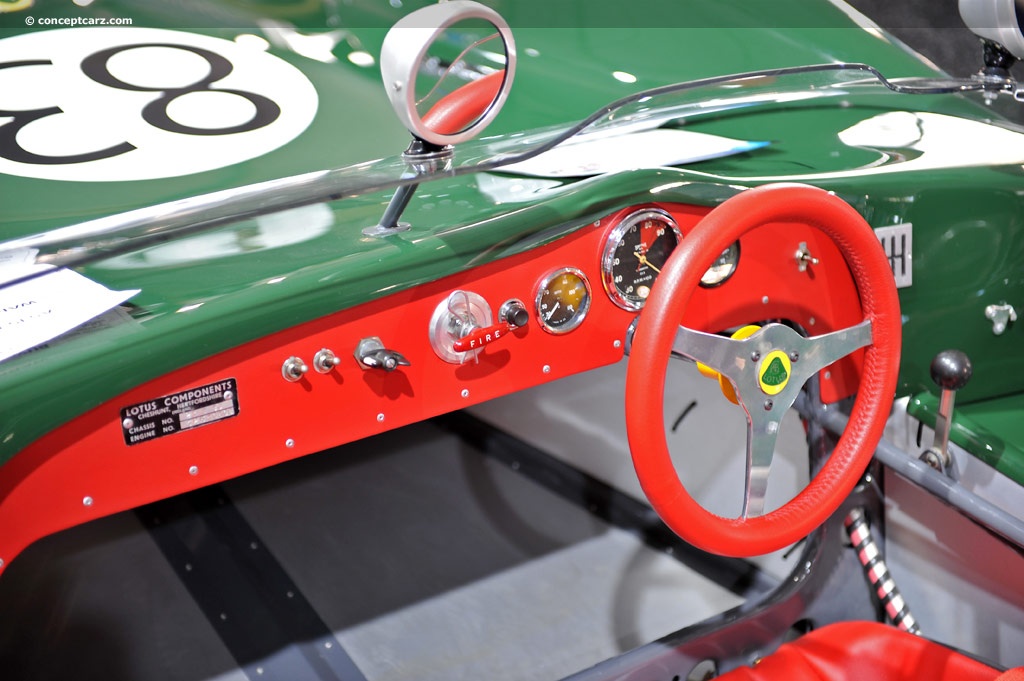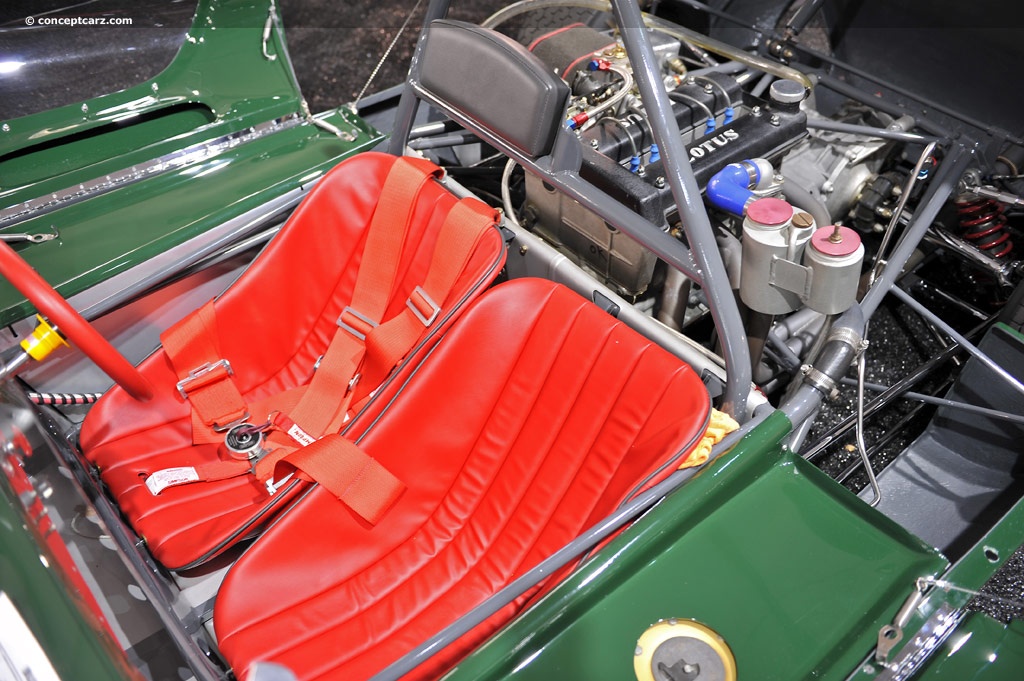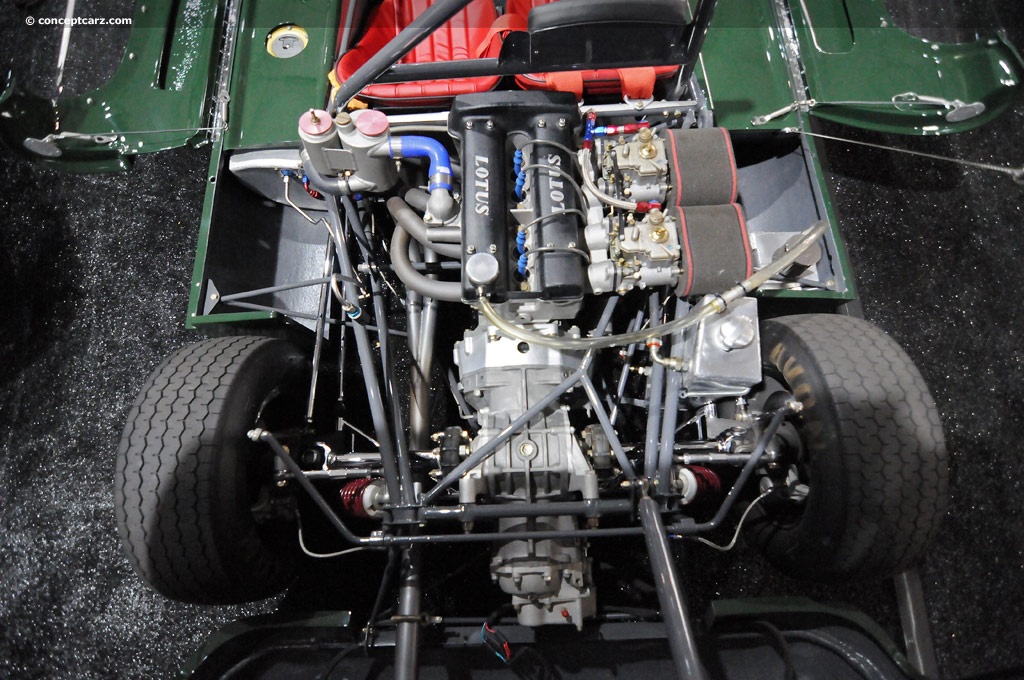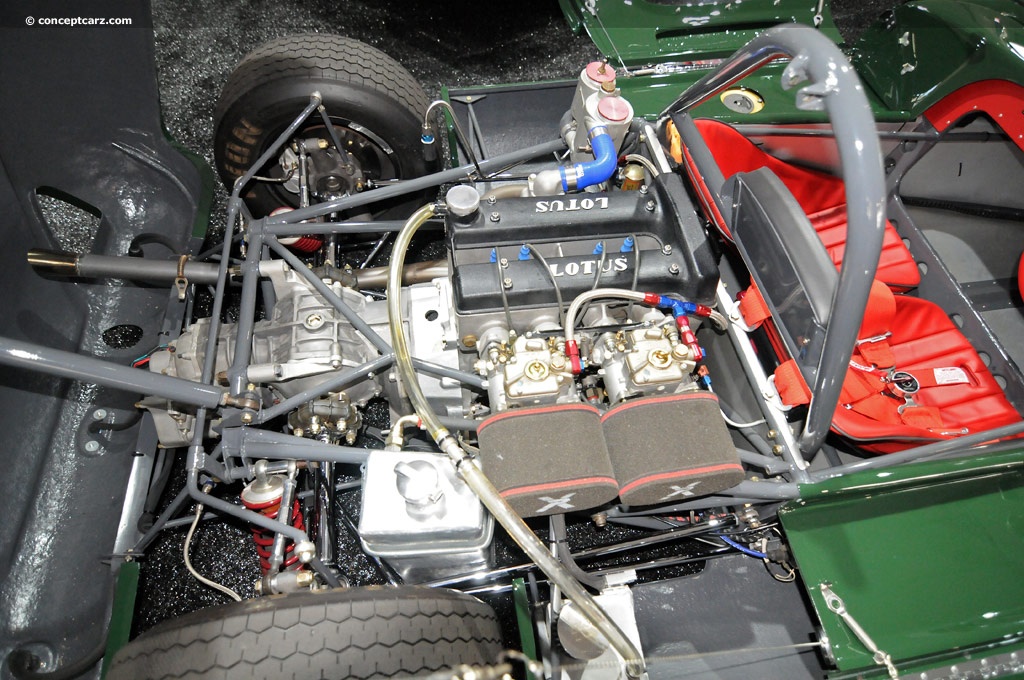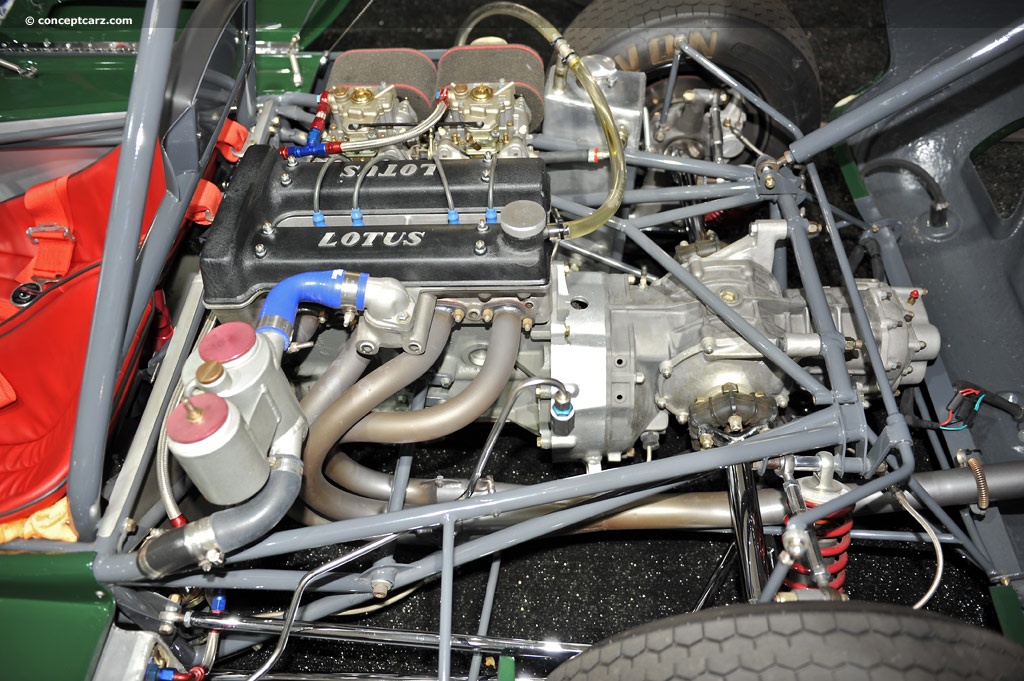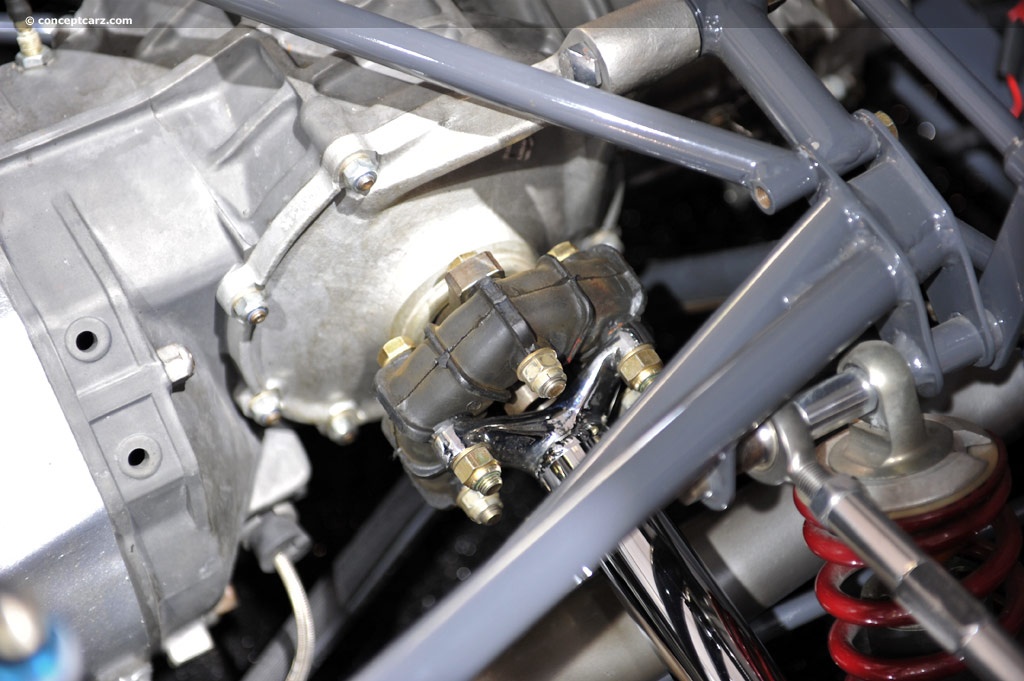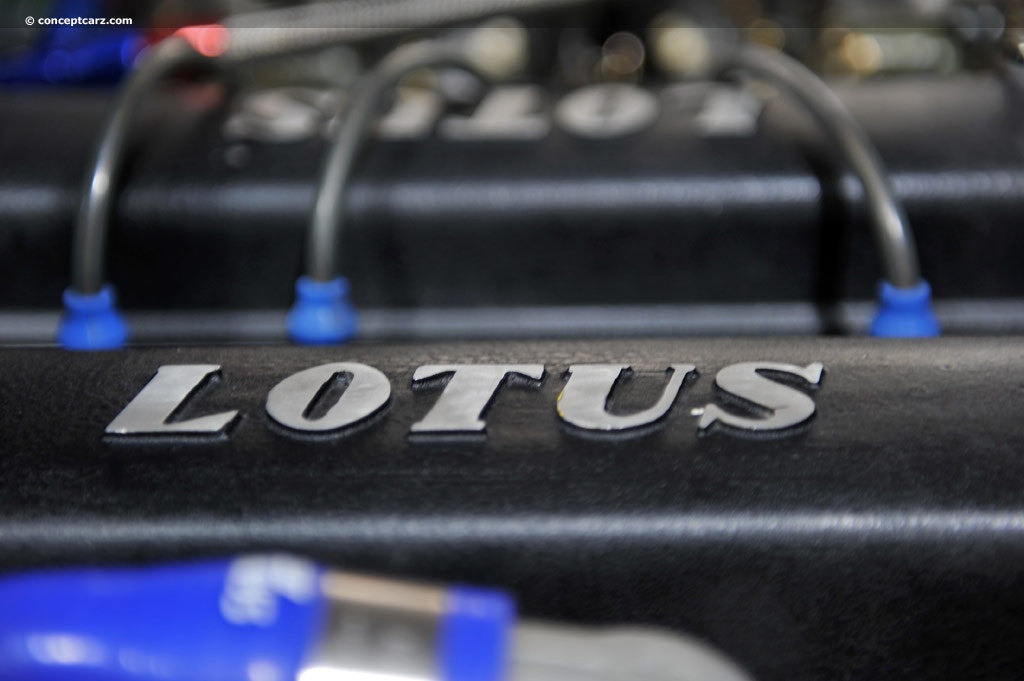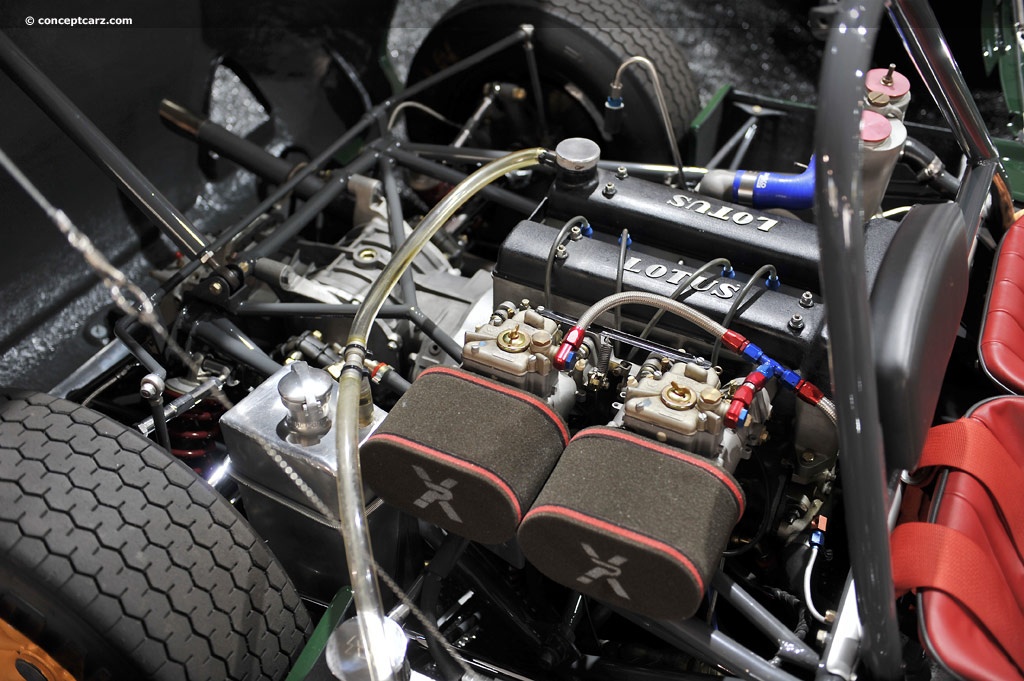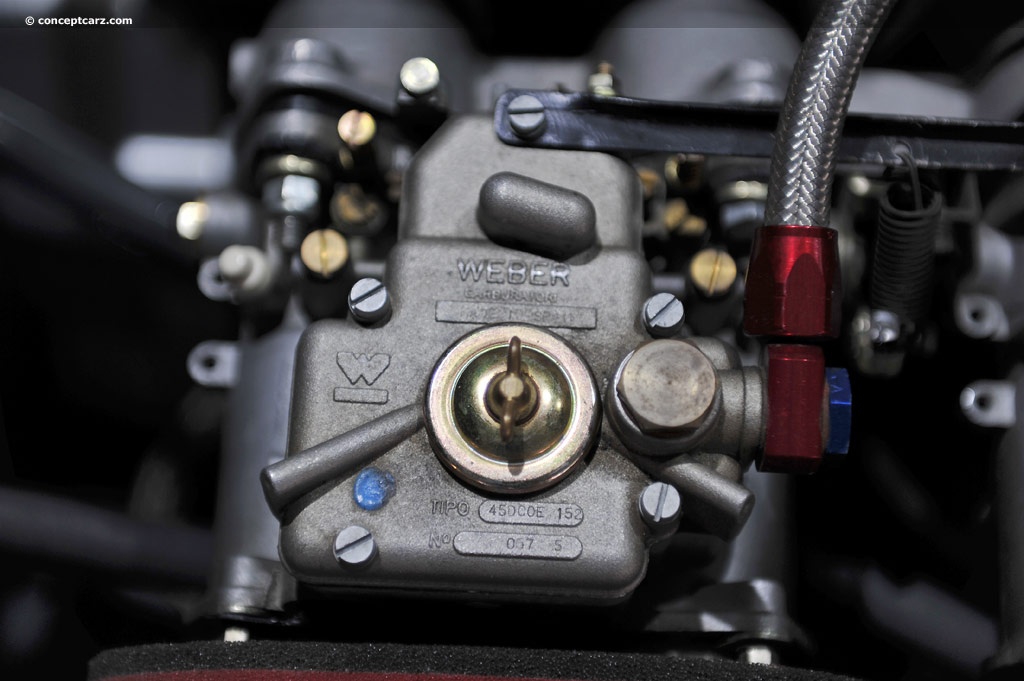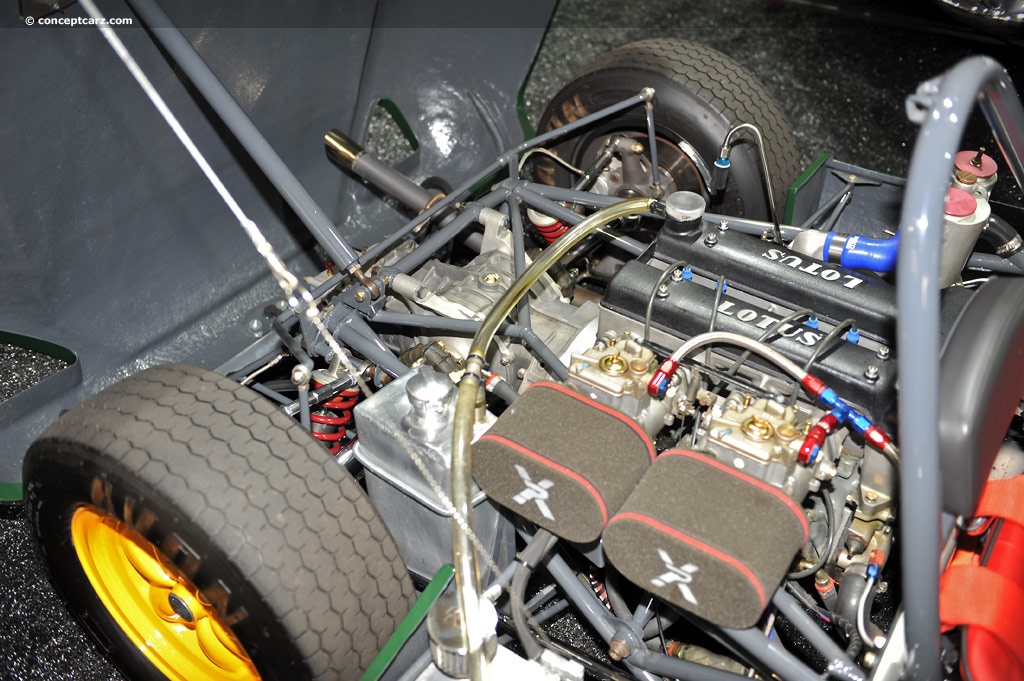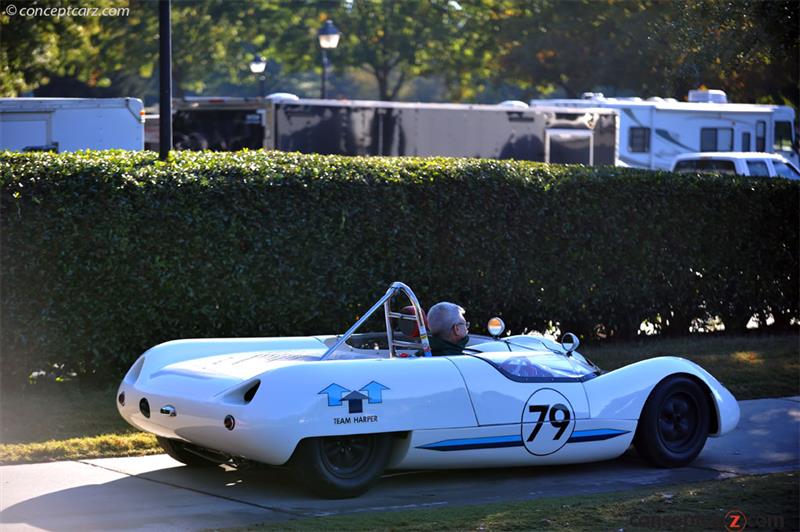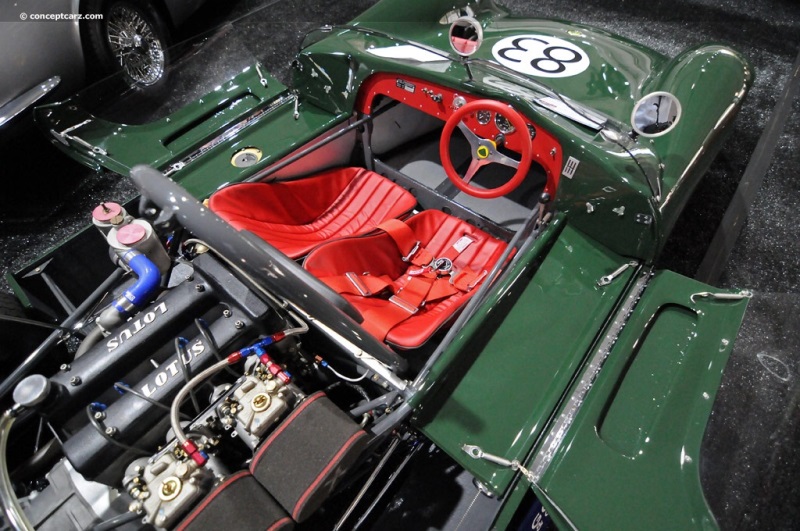Image credit: © conceptcarz.com (Reproduction Or reuse prohibited).
Colin Chapman would leave after numerous meetings with scrutineers. Furious, Chapman would exclaim, 'We shall never again race at Le Mans'. And after objections about carrying spare wheels and his Lotus' wobbly-web wheel design the world would miss out on an incredible opportunity to see Lotus race at Le Mans in 1962. Furthermore, it would be a lost opportunity to see Lotus' latest design, one that had left the competition behind a month earlier, take on its more-powerful competition.
The controversy that would lead up to Lotus' absence from the 1962 Le Mans and every subsequent Le Mans until 1997, long after Colin Chapman's death, wouldn't necessarily be about wobbly-web wheels. French teams would bring about some political pressure that would end up having Lotus' car disallowed on technical grounds. But the teams had good reason for the action.
In May of 1962, Lotus would arrive at the Nurburgring, and the 14 mile Nordschleife, with a brand new car. Compared to the Porsches, Aston Martins and Ferraris in the field the new car was small, with a small amount of horsepower. However, the team would have Jim Clark at the wheel.
Colin Chapman's designs were all classic emulations of his philosophy. Chapman was a firm believer in making car designs that were extremely lightweight and simple. He then knew that a lightweight and well-balanced design could make due with a smaller engine. A smaller engine, despite producing less horsepower, had such advantages as better weight distribution and much more compact designs given the smaller engine size.
On a wet day in May, Lotus' new chassis would take to the infamous Nordschleife in preparation to take on the other mighty teams assembled. With Jim Clark at the wheel, the Lotus would tear away from the line on the very first lap of the race and would begin to steadily pull away from the other cars. This seemingly upstart chassis would continue to pull away from the rest of the field until Clark enjoyed a nearly 30 second lead over Dan Gurney in a Porsche. Clark continued to pull away or maintain his advantage, even when the track dried out. It seemed more than clear that Clark would take this new chassis on to victory. However, a crack in the exhaust header would cause Clark to become overwhelmed by the fumes. This would lead to Clark eventually crashing the car after victory seemed absolutely certain.
While the debut would not be successful, it would certainly be a noteworthy performance. It would be such a performance that it would be rumored the big teams were scared about their prospects when Le Mans rolled around in June. The small car that would have the big teams scared would be Lotus' model 23.
Colin Chapman's move to designing small, compact mid-engine single-seater grand prix cars would make Lotus successful. In 1960, Lotus had produced its 18 single-seater and the lightweight car would quickly prove to be faster than just about every other grand prix car in history. The success of the single-seater model would cause Chapman to wonder about making a two-seater sports car model.
Designer Frank Costin had gained invaluable experience in aviation engineering and would become well known for design incredibly sleek designs. He would help Chapman by designing and building the Mark IX. Utilizing space frame construction, the aluminum-bodied sports car would measure just a little over two feet high. This model would be very popular and quite successful.
Fiberglass would fit neatly into Chapman's penchant for simplicity and futuristic and sleek design. The molding of the fiberglass enabled much more sleek designs with lower profiles and rounded shapes. Fiberglass also made things simpler since whole panels could be made and formed from fiberglass instead of individual panels of aluminum needing to be made. Of course, the major advantage of the fiberglass body came in its strength and its lightweight properties.
Chapman and Costin would use the advantages offered by fiberglass to design the Lotus 20. Because of the properties of fiberglass, Chapman could design a strong lightweight car with a very low profile and with a very sleek design. Simplistic meant low drag. And being for Formula Junior, the Lotus 20 was certainly small. It would then dawn on Chapman about just doubling the width of the 20 to create a sports car. Quite literally, the attempt wasn't to make a sports car but to make a single-seater legal for sports car racing.
At just a little less than 12 feet long and a height of just 2 feet and 3 inches at the top of the windscreen, the car was certainly molded and shaped like a single-seater grand prix car. The car was, for all intents and purposes, a grand prix car just widened. The design would be the 20 just widened. It would use the same four-wheel independent coil-spring suspension and would also have the four-wheel hydraulic disc brakes. About the only difference between the two would be the fact the 23 would have elegantly shaped fenders covering the wheels. And while the 23 would have two seats, it would be very much just an expanded single-seater cockpit.
Because of small size and incredible light weight of only around 1,030 pounds, an engine with a small displacement would be good enough and would remain hidden under the bodywork. The original 23 would use a 750cc up to a 1300cc engine. A revised 23, called the 23B, had stronger chassis tubes, and therefore, had the ability to handle the greater torque produced by the Lotus Twincam 1.5/1.6-liter engine. The 1.6-liter, four-cylinder engine producing 187 bhp would certainly be a strong enough competitor, especially considering the fact the original 23 would be called the 'giant killer'. Considering the Lotus 23 would only go on to be produced between 1962 and 1963, the car would have to be considered one of the best sports cars of its day as it would go on to earn a great deal of success in the smaller classes and would consistently give the more powerful cars fits due to its lightweight design that enabled it to be very quick and very nimble. Even years after its incredible debut at the Nurburgring in the wet when Clark had the race sown up, the car would continue to be a strong contender and would be a favorite in vintage sports car races.
Considered one of Costin and Chapman's greatest designs, especially in sports cars, a 23B Sports Racer would be made available at the 2012 RM Auction in Arizona. Chassis 23S80 was expected to earn between $175,000 and $225,000 at auction in no small way due to its intriguing history.
Completed late in 1962, this 23B would be sold to a Mr. W. Bradshaw in November of 1962. It would remain in England taking part in races through the U.K. and Europe. It would continue to take part in races all the way into the 1980s where it would then be shipped to the United States.
In 1986, upon its arrival in the United States, Mike Rahal would acquire the car from the famous Brumos Racing organization. Mike's last name probably looks a little familiar as he is the father of Bobby Rahal, who was, at the time of Mike coming to own the Lotus, the Indianapolis 500 champion. Mike Rahal would take the car and would compete in a number of vintage racing events for the next couple of years.
Then, in 1988, after just two years of owning the Lotus, Rahal would sell the car to Ed Henning of Charleston, South Carolina. Henning would continue to race the car for a few years. After a while, Henning would decide to have the car completely restored. This would not be scheduled to take place until 2000. Keith Mastriforte of Special Cars Only in Oldsmar, Florida would be chose to perform the work. However, Mr. Henning's passing in July of 2001 would delay the restoration of the car for a number of years. It would finally be restarted in 2006 by Henning's wife.
The car would finally be completed in 2008. Upon completion of the work the car would turn a few laps during the Targa Sixty-Six. Brian Redman would have the honor of taking the car through some of its paces and would be delighted with the experience. He would be noted as saying the car was, 'set up perfectly'.
Finished in British Racing Green, which was the livery of Team Lotus, and the bright red interior, this 23B would make an appearance at the 2008 Amelia Island Concours d'Elegance. Accented by signature yellow 'wobbly web' wheels this car, if it can be seen because of its size, certainly attracts attention. And what people will be looking at, when they peer at this incredibly small sports car is a race car that likely had the best manufacturers in the world rather scared and not wanting to race against it at Le Mans either.
Sources:
'Feature Lots: Lot No. 254: 1962 Lotus 23B Sports Racer', (http://www.rmauctions.com/FeatureCars.cfm?SaleCode=AZ12&CarID=r227&fc=0). RM Auction. http://www.rmauctions.com/FeatureCars.cfm?SaleCode=AZ12&CarID=r227&fc=0. Retrieved 10 January 2012.
'Lotus 23B', (http://regogoracing.com/?page_id=123). Regogo Racing. http://regogoracing.com/?page_id=123. Retrieved 10 January 2012.
'Welcome', (http://www.xanthoscars.co.uk/uk/WelcomePage.htm). Xanthos Sports Cars: Real Racing Cars. http://www.xanthoscars.co.uk/uk/WelcomePage.htm. Retrieved 10 January 2012.
Wikipedia contributors, 'Lotus 23', Wikipedia, The Free Encyclopedia, 20 September 2011, 22:43 UTC, http://en.wikipedia.org/w/index.php?title=Lotus_23&oldid=451580727 accessed 11 January 2012
Wikipedia contributors, 'Lotus 20', Wikipedia, The Free Encyclopedia, 11 August 2011, 12:10 UTC, http://en.wikipedia.org/w/index.php?title=Lotus_20&oldid=444251752 accessed 11 January 2012
Wikipedia contributors, 'Lotus 18', Wikipedia, The Free Encyclopedia, 11 August 2011, 21:01 UTC, http://en.wikipedia.org/w/index.php?title=Lotus_18&oldid=444331848 accessed 11 January 2012By Jeremy McMullen
The controversy that would lead up to Lotus' absence from the 1962 Le Mans and every subsequent Le Mans until 1997, long after Colin Chapman's death, wouldn't necessarily be about wobbly-web wheels. French teams would bring about some political pressure that would end up having Lotus' car disallowed on technical grounds. But the teams had good reason for the action.
In May of 1962, Lotus would arrive at the Nurburgring, and the 14 mile Nordschleife, with a brand new car. Compared to the Porsches, Aston Martins and Ferraris in the field the new car was small, with a small amount of horsepower. However, the team would have Jim Clark at the wheel.
Colin Chapman's designs were all classic emulations of his philosophy. Chapman was a firm believer in making car designs that were extremely lightweight and simple. He then knew that a lightweight and well-balanced design could make due with a smaller engine. A smaller engine, despite producing less horsepower, had such advantages as better weight distribution and much more compact designs given the smaller engine size.
On a wet day in May, Lotus' new chassis would take to the infamous Nordschleife in preparation to take on the other mighty teams assembled. With Jim Clark at the wheel, the Lotus would tear away from the line on the very first lap of the race and would begin to steadily pull away from the other cars. This seemingly upstart chassis would continue to pull away from the rest of the field until Clark enjoyed a nearly 30 second lead over Dan Gurney in a Porsche. Clark continued to pull away or maintain his advantage, even when the track dried out. It seemed more than clear that Clark would take this new chassis on to victory. However, a crack in the exhaust header would cause Clark to become overwhelmed by the fumes. This would lead to Clark eventually crashing the car after victory seemed absolutely certain.
While the debut would not be successful, it would certainly be a noteworthy performance. It would be such a performance that it would be rumored the big teams were scared about their prospects when Le Mans rolled around in June. The small car that would have the big teams scared would be Lotus' model 23.
Colin Chapman's move to designing small, compact mid-engine single-seater grand prix cars would make Lotus successful. In 1960, Lotus had produced its 18 single-seater and the lightweight car would quickly prove to be faster than just about every other grand prix car in history. The success of the single-seater model would cause Chapman to wonder about making a two-seater sports car model.
Designer Frank Costin had gained invaluable experience in aviation engineering and would become well known for design incredibly sleek designs. He would help Chapman by designing and building the Mark IX. Utilizing space frame construction, the aluminum-bodied sports car would measure just a little over two feet high. This model would be very popular and quite successful.
Fiberglass would fit neatly into Chapman's penchant for simplicity and futuristic and sleek design. The molding of the fiberglass enabled much more sleek designs with lower profiles and rounded shapes. Fiberglass also made things simpler since whole panels could be made and formed from fiberglass instead of individual panels of aluminum needing to be made. Of course, the major advantage of the fiberglass body came in its strength and its lightweight properties.
Chapman and Costin would use the advantages offered by fiberglass to design the Lotus 20. Because of the properties of fiberglass, Chapman could design a strong lightweight car with a very low profile and with a very sleek design. Simplistic meant low drag. And being for Formula Junior, the Lotus 20 was certainly small. It would then dawn on Chapman about just doubling the width of the 20 to create a sports car. Quite literally, the attempt wasn't to make a sports car but to make a single-seater legal for sports car racing.
At just a little less than 12 feet long and a height of just 2 feet and 3 inches at the top of the windscreen, the car was certainly molded and shaped like a single-seater grand prix car. The car was, for all intents and purposes, a grand prix car just widened. The design would be the 20 just widened. It would use the same four-wheel independent coil-spring suspension and would also have the four-wheel hydraulic disc brakes. About the only difference between the two would be the fact the 23 would have elegantly shaped fenders covering the wheels. And while the 23 would have two seats, it would be very much just an expanded single-seater cockpit.
Because of small size and incredible light weight of only around 1,030 pounds, an engine with a small displacement would be good enough and would remain hidden under the bodywork. The original 23 would use a 750cc up to a 1300cc engine. A revised 23, called the 23B, had stronger chassis tubes, and therefore, had the ability to handle the greater torque produced by the Lotus Twincam 1.5/1.6-liter engine. The 1.6-liter, four-cylinder engine producing 187 bhp would certainly be a strong enough competitor, especially considering the fact the original 23 would be called the 'giant killer'. Considering the Lotus 23 would only go on to be produced between 1962 and 1963, the car would have to be considered one of the best sports cars of its day as it would go on to earn a great deal of success in the smaller classes and would consistently give the more powerful cars fits due to its lightweight design that enabled it to be very quick and very nimble. Even years after its incredible debut at the Nurburgring in the wet when Clark had the race sown up, the car would continue to be a strong contender and would be a favorite in vintage sports car races.
Considered one of Costin and Chapman's greatest designs, especially in sports cars, a 23B Sports Racer would be made available at the 2012 RM Auction in Arizona. Chassis 23S80 was expected to earn between $175,000 and $225,000 at auction in no small way due to its intriguing history.
Completed late in 1962, this 23B would be sold to a Mr. W. Bradshaw in November of 1962. It would remain in England taking part in races through the U.K. and Europe. It would continue to take part in races all the way into the 1980s where it would then be shipped to the United States.
In 1986, upon its arrival in the United States, Mike Rahal would acquire the car from the famous Brumos Racing organization. Mike's last name probably looks a little familiar as he is the father of Bobby Rahal, who was, at the time of Mike coming to own the Lotus, the Indianapolis 500 champion. Mike Rahal would take the car and would compete in a number of vintage racing events for the next couple of years.
Then, in 1988, after just two years of owning the Lotus, Rahal would sell the car to Ed Henning of Charleston, South Carolina. Henning would continue to race the car for a few years. After a while, Henning would decide to have the car completely restored. This would not be scheduled to take place until 2000. Keith Mastriforte of Special Cars Only in Oldsmar, Florida would be chose to perform the work. However, Mr. Henning's passing in July of 2001 would delay the restoration of the car for a number of years. It would finally be restarted in 2006 by Henning's wife.
The car would finally be completed in 2008. Upon completion of the work the car would turn a few laps during the Targa Sixty-Six. Brian Redman would have the honor of taking the car through some of its paces and would be delighted with the experience. He would be noted as saying the car was, 'set up perfectly'.
Finished in British Racing Green, which was the livery of Team Lotus, and the bright red interior, this 23B would make an appearance at the 2008 Amelia Island Concours d'Elegance. Accented by signature yellow 'wobbly web' wheels this car, if it can be seen because of its size, certainly attracts attention. And what people will be looking at, when they peer at this incredibly small sports car is a race car that likely had the best manufacturers in the world rather scared and not wanting to race against it at Le Mans either.
Sources:
'Feature Lots: Lot No. 254: 1962 Lotus 23B Sports Racer', (http://www.rmauctions.com/FeatureCars.cfm?SaleCode=AZ12&CarID=r227&fc=0). RM Auction. http://www.rmauctions.com/FeatureCars.cfm?SaleCode=AZ12&CarID=r227&fc=0. Retrieved 10 January 2012.
'Lotus 23B', (http://regogoracing.com/?page_id=123). Regogo Racing. http://regogoracing.com/?page_id=123. Retrieved 10 January 2012.
'Welcome', (http://www.xanthoscars.co.uk/uk/WelcomePage.htm). Xanthos Sports Cars: Real Racing Cars. http://www.xanthoscars.co.uk/uk/WelcomePage.htm. Retrieved 10 January 2012.
Wikipedia contributors, 'Lotus 23', Wikipedia, The Free Encyclopedia, 20 September 2011, 22:43 UTC, http://en.wikipedia.org/w/index.php?title=Lotus_23&oldid=451580727 accessed 11 January 2012
Wikipedia contributors, 'Lotus 20', Wikipedia, The Free Encyclopedia, 11 August 2011, 12:10 UTC, http://en.wikipedia.org/w/index.php?title=Lotus_20&oldid=444251752 accessed 11 January 2012
Wikipedia contributors, 'Lotus 18', Wikipedia, The Free Encyclopedia, 11 August 2011, 21:01 UTC, http://en.wikipedia.org/w/index.php?title=Lotus_18&oldid=444331848 accessed 11 January 2012By Jeremy McMullen
2013 Gooding and Company - The Scottsdale Auction
Pre-Auction Estimates :
USD $175,000-USD $225,000
Sale Price :
USD $181,500
2012 RM-Automobiles of Arizona
Pre-Auction Estimates :
USD $175,000-USD $225,000
High Bid (Lot was not sold)
USD $130,000
2011 Gooding and Company - The Amelia Island Auction
Pre-Auction Estimates :
USD $175,000-USD $225,000
Sale Price :
USD $203,500
Recent Sales of the Lotus 23B
(Data based on Model Year 1962 sales)
| 1962 Lotus 23B Chassis#: 23S80 Sold for USD$181,500 2013 Gooding and Company - The Scottsdale Auction | |
| 1962 Lotus 23B Chassis#: 23 S 80 Sold for USD$203,500 2011 Gooding and Company - The Amelia Island Auction |
Lotus 23Bs That Failed To Sell At Auction
1962 Lotus 23B's that have appeared at auction but did not sell.
| Vehicle | Chassis | Event | High Bid | Est. Low | Est. High |
|---|---|---|---|---|---|
| 1962 Lotus 23 Sports Racing Car | 23S8 | 2017 Mecum : Monterey | $175,000 | ||
| 1962 Lotus Type 23 B 1 600 cm3 Sport Compétition | 23-S-73 | 2013 Bonhams Les Grandes Marques du Monde au Grand Palais | $90,000 | $110,000 | |
| 1962 Lotus 23B Sports Racer | 23S80 | 2012 RMAutomobiles of Arizona | $130,000 | $175,000 | $225,000 |
| 1962 Lotus Type 23B 1,600cc Sports Racer | 23-S-22 | 2010 Bonhams Les Grandes Marques a Monaco | $80,000 | $120,000 |
Vehicles With Comparable Market Values
Similar sales to the $192,500 range.
| 2023 Dodge Challenger SRT Demon 170 Chassis#:2c3cdzl97ph101045 Sold for $192,500 2024 Mecum : Houston | |
| 1967 Ford Mustang Custom Fastback Chassis#:7r02t222180 Sold for $192,500 2024 Mecum : Glendale | |
| 1933 Hispano-Suiza Junior berline par Vanvooren Chassis#:7111 Sold for $192,843 2024 Artcurial : Retromobile | |
| 1961 Maserati 3500 GT Coupé Coachwork by Carrozzeria Touring Chassis#:AM101.1470 Sold for $193,671 2024 Bonhams : Les Grandes Marques du Monde a Paris | |
| 2013 McLaren 12C 'Bespoke Project 8' Spider Chassis#:SBM11BAA6DW002088 Sold for $193,200 2024 RM Sothebys : Arizona | |
| 2023 CHEVROLET CORVETTE Z06 70TH ANNIVERSARY COUPE Chassis#:1G1YF2D31P5700309 Sold for $192,500 2024 Barrett-Jackson : Scottsdale AZ | |
| 2023 JEEP GLADIATOR CUSTOM PICKUP HELLEPHANT Chassis#:1C6JJTEG1PL581050 Sold for $192,500 2024 Barrett-Jackson : Scottsdale AZ | |
| 1972 CHEVROLET K5 BLAZER CUSTOM SUV Chassis#:CKE182S125063 Sold for $192,500 2024 Barrett-Jackson : Scottsdale AZ | |
| 1960 CADILLAC ELDORADO BIARRITZ CONVERTIBLE Chassis#:60E108328 Sold for $193,600 2024 Barrett-Jackson : Scottsdale AZ | |
| 1964 CHEVROLET CORVETTE 327/365 CONVERTIBLE Chassis#:40867S118510 Sold for $192,500 2024 Barrett-Jackson : Scottsdale AZ | |
| 1956 CHEVROLET 3100 CUSTOM PICKUP REDEFINED Chassis#:V3A56L015248 Sold for $192,500 2024 Barrett-Jackson : Scottsdale AZ | |
| 1970 DODGE CHALLENGER CUSTOM CONVERTIBLE Chassis#:JH27G0B112701 Sold for $192,500 2024 Barrett-Jackson : Scottsdale AZ | |
| 1960 CADILLAC COUPE DE VILLE CUSTOM HARDTOP Chassis#:60G010949 Sold for $192,500 2024 Barrett-Jackson : Scottsdale AZ | |
| 1953 FORD F-100 CUSTOM PICKUP Chassis#:AZ393371 Sold for $192,500 2024 Barrett-Jackson : Scottsdale AZ | |
| 1982 TOYOTA LAND CRUISER FJ43 CUSTOM SUV Chassis#:FJ43109975 Sold for $192,500 2024 Barrett-Jackson : Scottsdale AZ | |
| 1971 Chevrolet Corvette Coupe Chassis#:194371s113413 Sold for $192,500 2024 Mecum : Kissimmee | |
| 1912 Lanchester Model 25 Tourer Chassis#:1434 Sold for $192,089 2023 Bonhams : The Golden Age of Motoring Sale | |
| 1963 Chevrolet Corvette Convertible Chassis#:30867s118131 Sold for $192,500 2023 Mecum : Dallas | |
| 1990 Ferrari Testarossa Sold for $193,200 2023 Worldwide Auctioneers : The Auburn Auction | |
| 2023 Chevrolet Corvette Z06 3LZ Sold for $191,520 2023 Worldwide Auctioneers : The Auburn Auction |
